THE FREEDMEN
Sample Documents
The following are examples of some of the documents relating to the Freedmen of the Five Civilized Tribes.
Prior to 1896, the tribes exercised sole jurisdiction over tribal citizenship, but in that year Congress passed an act allowing the Commission to hear and "determine the applications of all persons who may apply to them for citizenship and...determine the right of such applicant to be admitted and enrolled." The Dawes Commission issued notices on July 8, 1896, announcing that it would accept applications for citizenship until September 10, 1896. The application had to be a signed and sworn statement containing all the facts supporting the claim, and the applicant had to provide proof that a copy had been furnished to the tribal chief. Congress required the Commission to make its decision within 90 days of receipt of the application and authorized an appeal process through the recently established U. S. Court in Indian Territory. These applications are know as the 1896 Citizenship Cases. The index to the Chickasaw and Choctaw Freedmen 1896 Citizenship Cases are on this website.
One of the most important documents relating to the Freedmen is the Dawes Census Enrollment card. These cards contain genealogical data for a family and its members. It provides the name, age and sex for each family member and will contain the slave owners name for an individual if that person was held in bondage. The Dawes Census Enrollment cards were compiled circa 1898, with followups through 1905. The indexes to the Chickasaw Freedmen and Choctaw Freedmen are available on this web site.
The application jacket is to be used in conjunction with the census card and will contain information to support the applicants claim. The application jacket almost always contains information relating to the family on the corresponding census card and may contain information on other family members on other census cards. The application jacket may contain testimony (usually by the "head of household"), marriage certificates, birth affividats, death affividats, and various correspondence. Each applilcation jacket is different; one never knows what one may find in the application jacket. The application jacket contents were compiled circa 1898-1905
During the early 1900's Allottment Certifcates and Patents were issued to the Freedmen when they received their land allottment (usually 40 acres). These documents contain the legal description of the land. Once a researcher has obtained the legal description, they may order a title search which will detail what happended to the land; whether it was sold, or whether it was seized in lieu of back taxes, for example. These warranty or tax deeds may also list the name of a spouse or another person holding title. The Hastings List, which contains the legal description for the land allotted to the Chickasaw and Choctaw Freedmen, is contained on this web site.
The Indian Pioneer Paper Interviews were interviews that were conducted in the late 1930's. Those interviewed were people of African, Indian and pioneer heritage. These interviews include biographical data on both living and deceased persons. The interviews usually consist of two documents; the questionaire and the interview. The index to the Indian Pioneer Paper Interviews is contained on this web site.
Also included are the slave narratives of three (3) Freedmen. These narratives are anodototal in nature and sometimes contain genealogical information as well as information regarding the people, the times, and the customs.
1896 Dawes Citizenship Cases
Typical application files include supporting affidavits, depositions, letters, memorials, answers of tribal attorneys objecting to enrollment, lists of evidence, and receipts for service of papers.
Below are the contents of my paternal great grandfather, Thomas Stephesons 1896 Citizenship Application. Included in his application is an affivadat by Laney Stepheson, my paternal great-great-great-grandmother.
1896 Citizenship Application - Thomas Stephenson
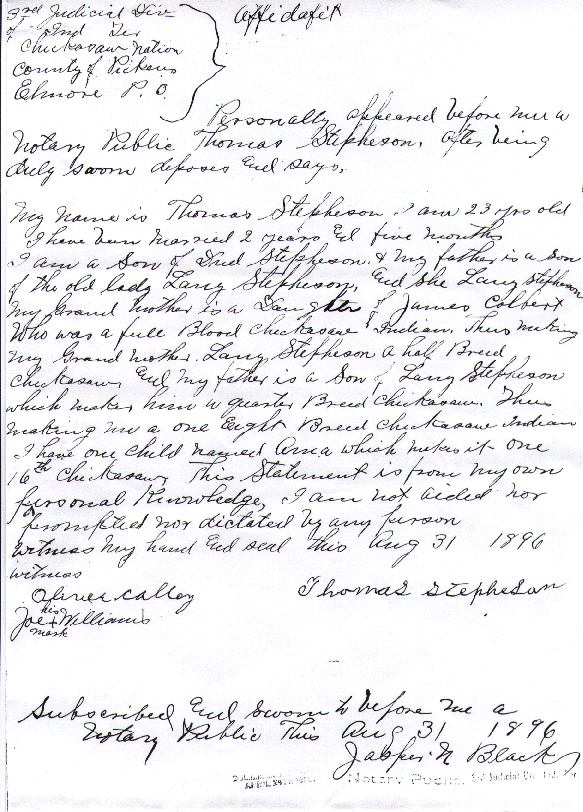
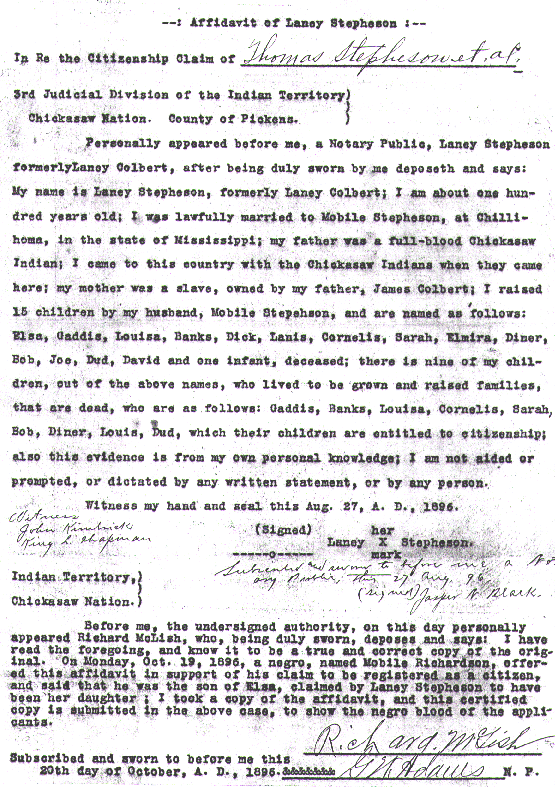
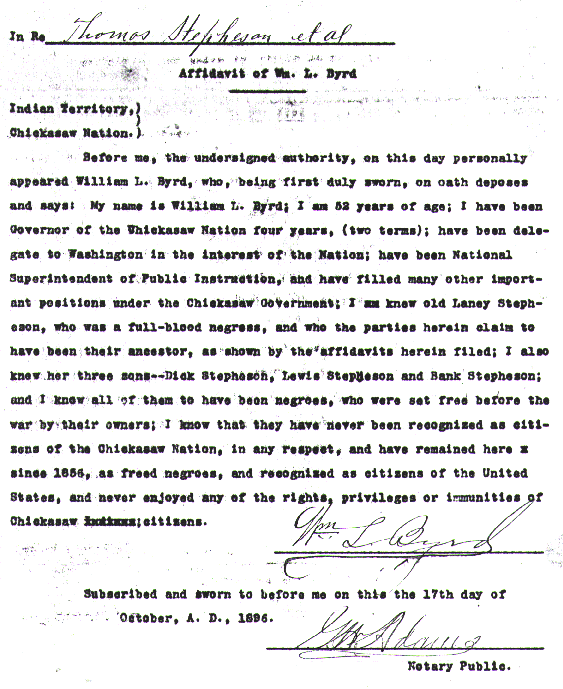
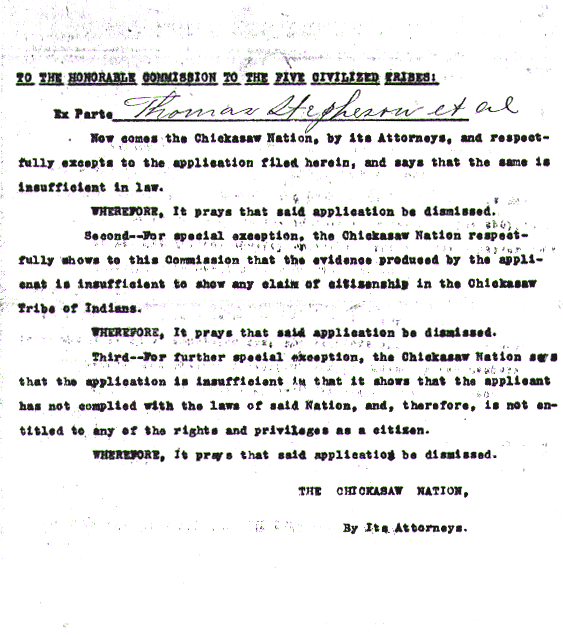
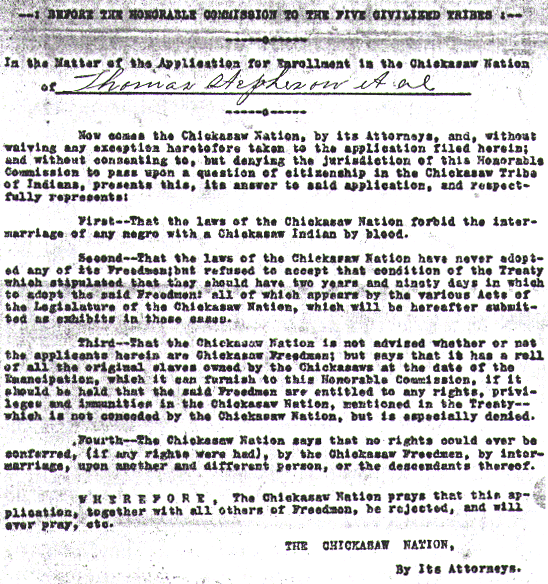
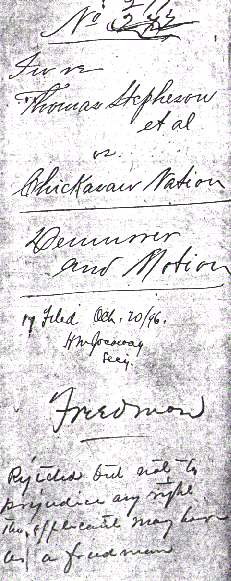
Dawes Census Cards
The Dawes Census cards for the Freedmen of the Chickasaw and Choctaw consist of two pages.
The first page list information regarding the family. It shows the tribe in which the individuals were enrolled. The person listed in the first box is the "head of household" and the others are members of that household. The relationships listed are in relation to the "head of household". The first page also list other genealogical data regarding the individual including their age and sex. The slave owners name is listed if any of the individuas were held in bondage. Special notes may also be included in the bottom half of the first page of the census card. These notes may provide additional information on the individuals or family. These notes may direct the researcher to other census cards of additional family members. The card also list the post office and county where the family resided. Usually at the bottom left (sometimes right) there is a stamp which shows which individuals where enrolled and the date of enrollment
The second page list the parents of the individuals on the first page. This information gives the Freedmen researcher information on another generation. Whereas, the first page list information on an individual, the second page list information on the parentage of the individuals listed on page 1. Page 1 and Page 2 are designed to be used in conjuction with each other. I find it helpful to separate the pages and place them side by side. The information on the lines of page 2 correspond to the appropriate aperson listed on that same line on page 1. When No.1 or No.2 or No. 7, for example, is used, it refers to the person listed on page 1 at that line.
Census Card Page 1
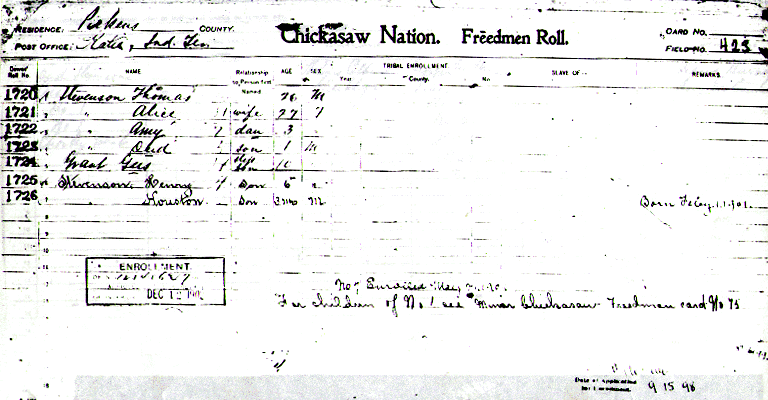
Census Card Page 2
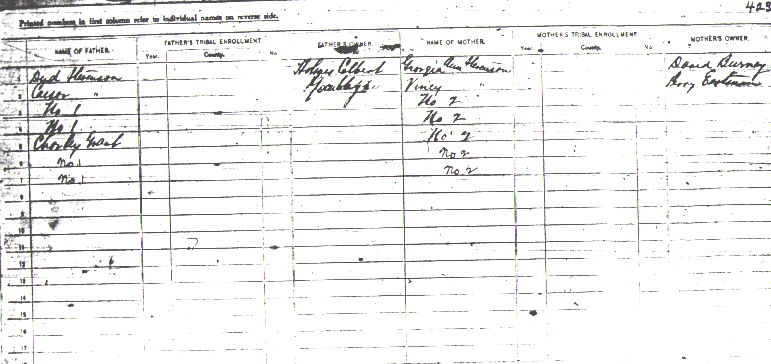 >
>
Dawes Application Jacket
The application jacket contains information on the family listed on the census card. One never knows what one will find when looking at the application jacket. The application jacket may contain Affidavits, marriage certificates, birth affidavits, death affidavits, and correspondence as well as a sundry of other documents.
Affidavit






Statement
Marriage License
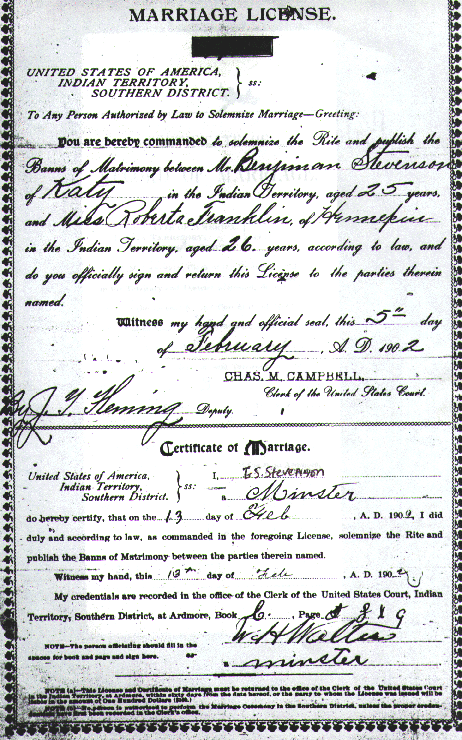
Certificate of Record of Marriage
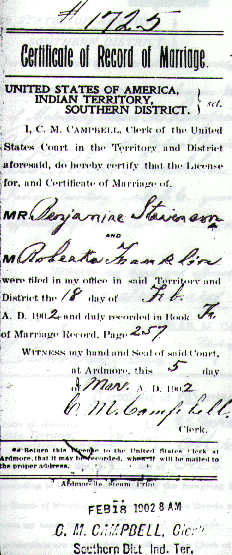
Birth Affidavit
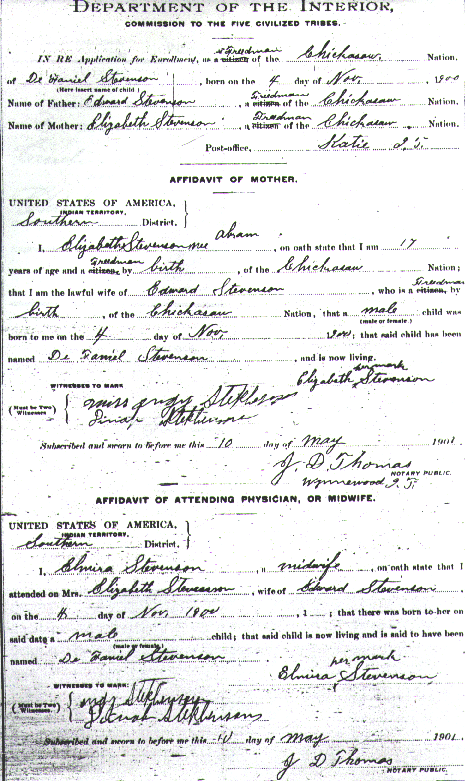
Birth Affidavit Coversheet
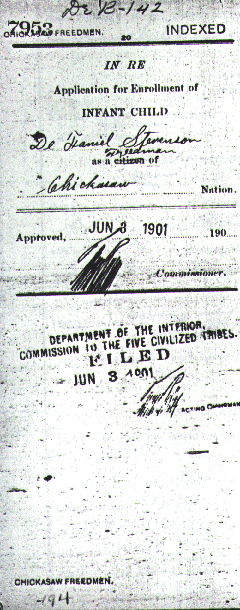
Death Affidavit
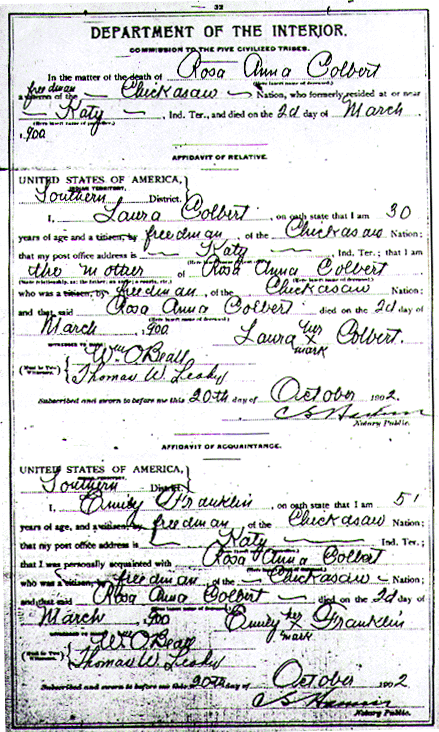
Death Affidavit Coversheet
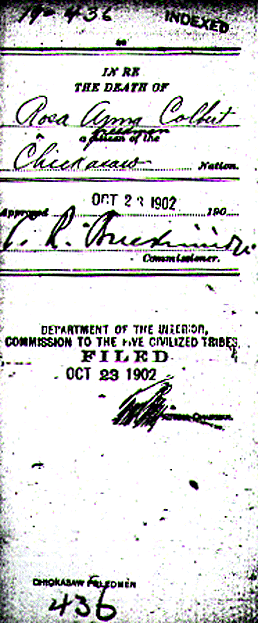
Correspondence



Allotment Certificate
Houston B. Stevenson's Allottment Certificate
The following allotment certificate was issued by the Department of the Interior (Commission of the Five Civilized Tribes) to my paternal grand father, Houston Brooks Stevenson, Sr. In addition to an allottment certificate a patent was issued as well.
In the upper left hand corner, of the allotment certificate, is listed the tribe (Chickasaw) and roll number (1726) for the enrollee. In the middle portion of the certificate is listed the name of the enrollee (Houston Stevenson), a legal description of the land (SE4of SW4of Section 31, Township 2N, Range 1W) and the amount of land alloted (40 Acres). The total appraised value of the land ($130.00) is near the bottom of the certificate. The allotment certificate was signed by XXXXXX. The allotment certificate list the certifcate number (2689) and the date the certificate was issued (March 16, 1904) in the upper right hand corner.
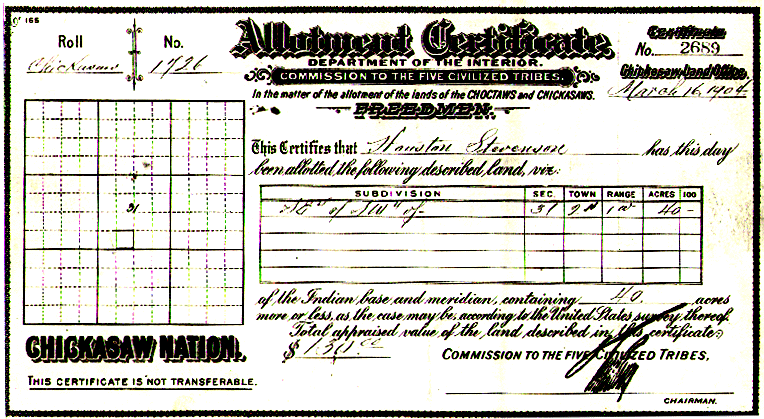
Patent
The following patent was issued by the Department of the Interior (Commission of the Five Civilized Tribes) to my paternal grand mother Millie Williams.
Patent Certificate
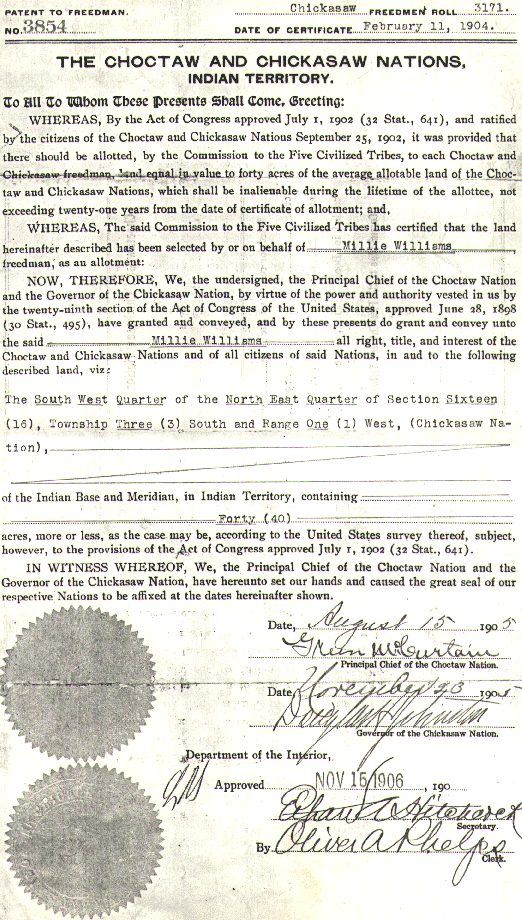
Patent Coversheet
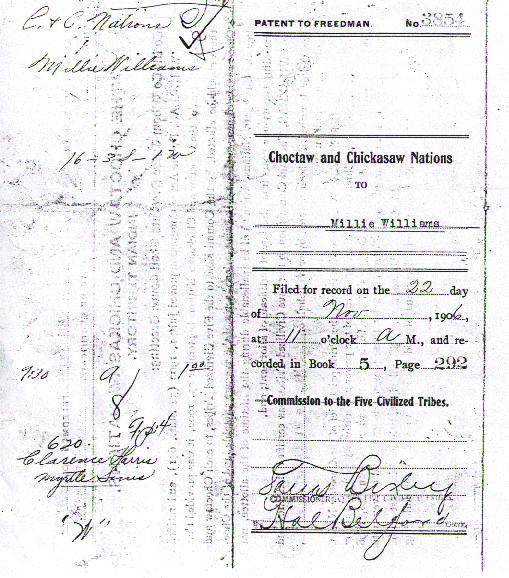
Indian Pioneer Paper
The Indian Pioneer Papers is a collection of interviews done in 1937 & 1938, which includes biographical data on both living and deceased persons of Indian and pioneer heritage whose lives have been important in the history of Oklahoma. There is also a collection of information on family customs, tribal histories, social organizations, folklore, legends, cemeteries, old trails, ferries, forts, trading centers and other unrecorded facts known only to oral tradition.
Indian Pioneer Paper Questionaire - Eli Roberts
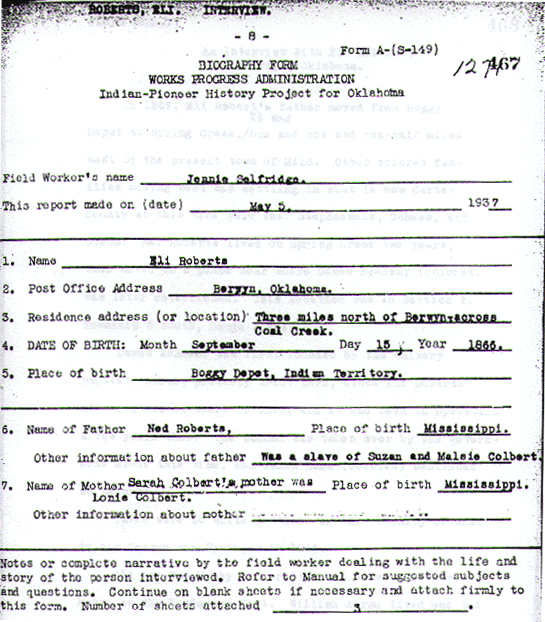
Indian Pioneer Paper Interview - Eli Roberts
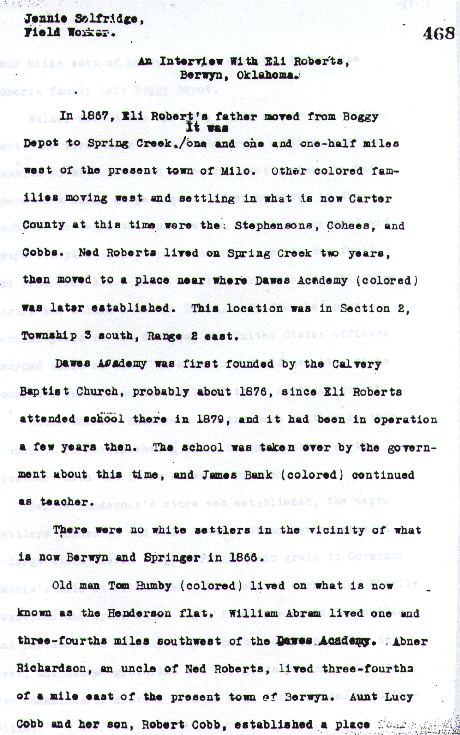
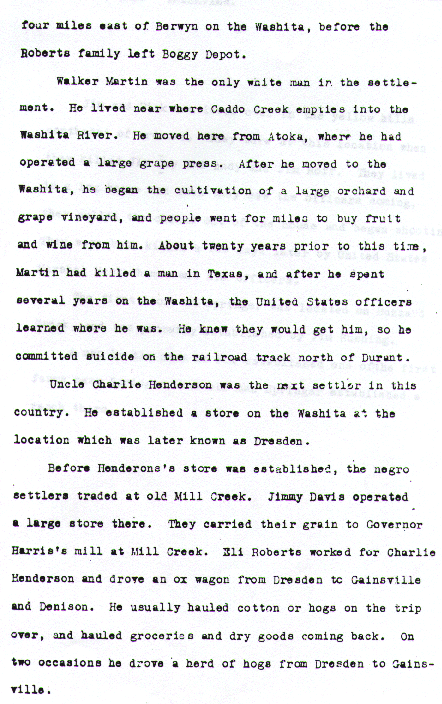
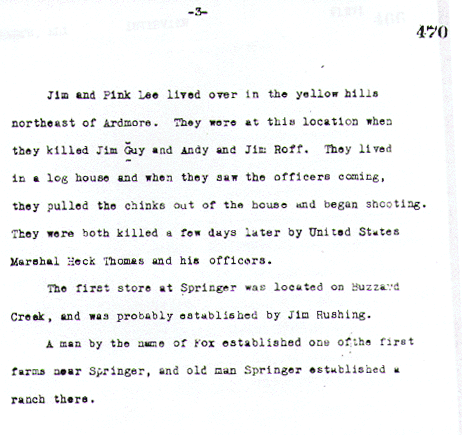
Slave Narratives
Introduction
The WPA Oklahoma Slave narratives contain the stories/interviews of elderly Oklahomans. Who were these elderly Oklahomans? They were Africian Americans who had been born into slavery and who in the mid-1930's shared the stories of their lives with field workers from the Oklahoma Writers' Project. Over a three-year period, former slaves were identified and interviewed by project personnel who sought them out and recorded their stories on notepads. As a consequence of this early oral-history project, we have a remarkable record today of the lives of pioneers who helped to shape society in Oklahoma1
Contained within, is an section -- About the Slave Narratives -- detailing several factors involved in the creation of the slave narratives, which is a "must read" and provides a key to understanding the slave narratives. In addition, three slave narratives: Francis Banks, Polly Colbert and Phoebe Banks are also included.
About the Slave Narratives
The Oklahoma slave narratives take the form of autobiographical accounts of the lives of black Oklahomans. For the most part the stories were prepared as the Oklahoma portion of a project undertaken in seventeen states to record the remembrances of African Americans who had been born into slavery. The narratives in reality consist of notes from interviews which were edited into a more-or-less standard format and presented as if they had not been prompted by the field reporters' questions. Once the interview transcripts were placed into this regular form, and sometimes reorganized to make them more understandable, the final typewritten drafts were forwarded to national project headquarters in Washington, D.C. There twenty-three hundred interviews with former slaves from several states, including seventy-five oral histories from blacks in Oklahoma, have been available to scholars for more that half a century.2 Not all of the interviews, however, were sent to Washington. In the case of Oklahoma, fifty-five additional interview were recorded but for one reason or another never forwarded, perhaps because they contained material at the time considered racially sensitive. The latter interviews today may comprise some of the most interesting.
In reading the slave narratives, one must be aware of several factors involved in their creation. Clearly the texts came from individuals who had lived as slaves and subsequently as freedmen and -women. They genuinely understood the experience of slavery from the inside, and many of them had conveyed it orally to their younger family members. By the time these individuals were interviewed in the mid 1930's, however, they were necessarily in their seventies, eighties, nineties, or even older. Over the years some of their memories had dimmed, while others remained as bright as if the events had just occurred. For many of the interviewees, the remembrances of slavery were those of childhood, lacking the harshness inherent in the memories of older respondents who had experienced slavery as adults.
The reporters sent to the field to collect the narratives were both black and white, and the responses elicited by white field workers likely differed considerably from those gathered by African American reporters. The 1930s rules of racial etiquette were carefully followed. Elderly informats dared not offend local white people or presumed agents of the federal government, so at times they told the filed reporters what they wanted to hear. Many of the interviewees began with an almost obligatory statement about how good their masters had been, before they proceeded to describe abuses and cruelty. Some apparently did have humane masters; other owners, however, were semmingly psychopathic. Readers of the slave narratives must approach them with the same caution applied to any other primary historical evidence. 3
The narratives themselves have certain textual characteristics. Reporters in the Oklahoma project tailored their interviews to a standard set of questions devised at the start of the project by John A. Lomax, director of the Folklore Division for the Federal Writers' Project. This division administered the national Slave Narrative Project. The use of Lomax's list of questions helped reporters to seek more substantive information than merely where a person lived, the names of his or her family members, or the identity of the master. Thus the field workers queried informants on such topics as foodways, how they had learned about their freedom, and health, medicine, and folk cures. Readers of the narratives often are struck by the informants' obvious answers to reporters' queries, even though the texts are edited so that the actual question do not appear.4
The national project office provided guidance on the rendering of African American dialect. Although in actual practice standardized dialect was not used in all the narratives, project personnel received guidelines on how to present speech in a uniform manner for the sake of literary consistency. Greater emphasis was always placed on correct recording of idioms that on pronunciation, but even so, "this" was genrally rendered "dis" and "that" was spelled "dat", no matter whether the informant spoke in standard or in dialect English.5
Although the individuals interviewed in the Oklahoma Slave Narrative Project lived within the state at the time they shared their remembrances with field workers, they did not necessarily live there while in bondage. Twenty-eight of the 130 informants were actually in servitude in present-day Oklahomas as slaves of American Indians who were members of the Creek, Cherokee, Chickasaw, or Choctaw nation.
One of the most intriguing aspects of the Oklahoma slave narratives is that some of them record a detailed inside view of slavery among the so-called Five Tribes. The Cherokee, Creeks, Chickasaws, and Choctaws all had taken from the Euro-Americans the practice of balck slavery, while the Seminoes chose to adopt blacks into their bands. When the federal government expelled these groups from their traditional homes in the southeastern United States, they took with them their black slaves. The Indians had a reputation for showing more humanity to their slaves than the whites, although these narratives illustrate a wide range of relations between the groups. The enculturation of the blacks into the tribes was so great that some slaves knew only Indian languages until after emancipation.
The Oklahoma slave narratives are a window -- a window in a past about which we know a great deal and about which we know very little. Through the memories of the interviewees, we can see and hear slavery from the inside -- throuh the eyes and ears of those who were bought and sold, who danced and cried, and who survived to tell of the almost feudal world of dirt-floored cabins, white columns, and bullwhips.
1For an overview of the WPA Oklahoma Slave Narrative Project, see Monroe Billington, "Black Slavery in Indain Territory: The Ex-Slave Narratives, "Chronicles of Oklahoma 60(Spring 1982): 56-65.
2Norman R. Yetman, "The Background of the Slave Narrative Collection, "American Quarterly 19 (Fall 1967): 534-53.
3John W. Blassingame, "Using the Testimony of Ex-Slaves: Approaches and Problems," Journal of Southern History 41 (November 1975): 473-92; Paul D. Escott, "The Art and Science of Reading WPA Slave Narratives," in The Slave's Narrative, 40-48; C. Vann Woodward, "History from Slave Sources," American Historical Review 79 (April 1974): 470-81.
4Botkin, Lay My Burden Down, xi. For the actual questions used by Slave Narrative Project personnel in the field, see U.S., Works Progress Administration, Federal Writers' Project, Slave Narratives, Alabama, box A917, 1:xx-xii, xxxi-xxxii, Manuscript Division, Library of Congress, Washington, D.C.; also available repreinted in George P. Rawick, ed., The American Slave: A Composite Autobiography, series I, 1:173-76.
5Sterling A. Brown, "On Dialect Corrections," typescript, 3 lvs., n.d., WPA Notes on Interviews; Federal Writers; Project, Slave Narratives, Alabams, 1:xvii,xxviii-xxx; John Edgar Wideman, "Charles Chesnutt and the WPA Narratives: The Oral and Literate Roots of Afro-American Literature," in The Slaves; Narrative, 59-78.
FRANCES BANKS1
I was born on a farm near Doaksville, east of Hugo, Okla., befo' de Civil War. My parents belonged to an Indian fam'ly, an we moved to Boggy Depot 2 when I was jest a little child. After de Rebellion we stayed on wid de fam'ly and I lived near d e fam'ly of Governor Allen Wright 3 for sixty years. I nussed all his chillun and den later, 'long come dey's chillun and I nussed dem, and I'se even nusssed de great gran'chillun.
After de War I was what you call a freedman. De Indians had to give all dey slaves forty acres of land. 4 I'se allus lived on dis land which jines dat of Ole Master's and I'se never stayed away from it long at a time. I'se allus been willing to go an nuss de sick an 'flicted, but I allus come back home for a while.
I makes dis liniment of my own p'escription, and it's good for nearly everything dat ails you. 5 A while back a man an a boy got snake-bit, and I put dis liniment on 'em and day was well in no time a'tall.
I has no real record of my being bawn but I think 6 I'se allus had good health and can do most any kind of work I wants to. My grandfather, Uncle Wallace, was a slave of the Wright fam'ly when dey lived near Doaksville, and he and my grandmother would pass de time by singing while dey toiled away in de cotton fields. Grandfather was a sweet singer. He made up songs and sung 'em. He made up "Swing Low Sweet Chariot" and "Steal away to Jesus." He made up lots more'n dem, but a Mr. Reid, a white man, liked dem ones de best and he could play music and he helped grandfather to keep dese two songs. I loves to hear 'em. 7
I don't 'memeber much 'bout slavery days, 'cepting us chillun had a right good time playing. We ain' never had no jobs to speak of, cause Old Master wanted all his young slaves to grow up strong and natchel like, and none of us never done no hard work till we was plumb grown and matured. Ole Master was allus good and kind to us. I'se allus lived 'round white folks. I guess I'se de lone sentinel 'round here now. I'se 'bout all dat's left of de old days. Ever'body have gone and left me. I loves my home here cause dese hills and valleys never change. I loves to hear de Bible read too. I never did learn to read though some day I'se gwine to be wid my old friends and if our skins here are black, dey won't be no colors in Heaven. Our souls will all be white.
1 At some date probably in autumn 1928, WPA field worker Mrs. Jessie R. Ervin interviewed Mrs. Frances Banks at Boggy Depot, Oklahoma. From her notes a preliminary draft of Bank's narrative was typed as "Interview with Frances Banks (Ex-Slave, Aged 82, Boggy Depot, Oklahoma)," available in the OHS Slave Narratives. On 20 October 1938 this text was revised into the typescript "Frances Banks," published here and also available in the OHS Slave Narratives. Responding to questions about the informant and her life experiences, Ervin on 8 Novemeber 1938 wrote to James M. Thompson, director of the Oklahoma Writer's Project, "I called Judge Allen Wright and he ways that she [Frances Banks] spoke the truth and that she is really a grand-daughter of Uncle Wallace Willis." The Frances Banks narrative was never sent on to Washington. Jessie Ervin, McAlester, Oklahoma, to James M. Thompson, Oklahoma City, Oklahoma, 8 November 1928, WPA Notes on Interviews.
2 For background on this location, see Muriel H. Wright, "Old Boggy Depot," Chronicles of Oklahoma 5 (March 1927): 3-17.
3 For background on Allen Wright, principal chief of the Choctaw Nation, 1866-70, see John Bartlett Meserve, "Chief Allen Wright," Chronicles of Oklahoma 19 (December 1941): 314-21.
4 Frances Banks, with her name spelled Francis Banks, was legally enrolled as a Choctaw freedwoman by the Daves Commission on 25 June 1902. U.S., Department of the Interior, Office of Indian Affairs, Dawes Commission, Choctaw Freedmen Census Cards, no. 1414 (Francis Banks), microcopy M1186, reel 12, National Archives and Records Administration, Fort Worth, Texas. For background on the lives of freedmen in post-Civil War Dilemma (sic)," Journal of the West 4 (July 1965): 367-76; Berlin B. Chapman, :Freedmen and the Oklahoma Lands," Southwestern Social Science Quarterly 29 (September 1948): 150-59; Angie Debo, The Rise and Fall of the Choctaw Republic, 89-90, 99-109, 133, 201, 215, 218, 249-50, 255, 259, 262, 275-78; Parthena Louise James, "Reconstruction in the Chickasaw Nation: The Freedmen Problem," Chronicles of Oklahoma, 45 (Spring 1967): 44-57; Wyatt P. Jeltz, "The Relations of Negroes and Choctaw and Chickasaw Indians," Journal of Negro History 33 (January 1948): 24-37; Lewis Anthony Kensell, "Phases of Reconstruction in the Choctaw Nation, 1865-1870," Chronicles of Oklahoma, 47 (Summer 1969): 138-53; Daniel F. Littlefield, Jr., The Cherokee Freedmen from Emancipation to American Citizenship; Daniel F. Littlefield, Jr., The Chickasaw Freedmen: A People without a Country ; Hanna R. Warren, "Reconstruction in the Cherokee Nation, "Chronicles of Oklahoma, 45 (Summer 1967) 180-89; Walt Wilson, "Freedmen in Indian Territory during Reconstruction," Chronicles of Oklahoma, 49 (Summer 1971): 230-44.
5 The preliminary draft of this narrative has the following sentences scratched out in pencil: "'Aunt Frances" spent much of her time in the home of Dr. W. N. Wright, a leading physician, and learned what she knows of medicine and nursing from him. She has had plenty of opporrtunity to practice this in the farming community in which she lives. She showed me a bottle of liniment, a formula of her own which she always carries with her. "I makes dis liniment an' it is good for nearly everything.'" Above these scrathched-out lines are the following manuscript notes: "I spent lots of time at Dr. W. N. Wright's house, and learned about nursing from him. I makes a liniment now, and it is good for nearly everything."
6 "'I'm about sixty-two &" included at this point in the preliminary version.
7 According to Oklahoma sources, Wallace Willis sang these songs to the Reverend Alexander Reid, superintendent of the Spencer Academy for Indians in the Choctaw Nation from 1849 to 1861, and it was Reid who made the two spirituals known in the outside world. "Swing Low: Federal Theater of Oklahoma, Works Progress Administration,: in "Fed. Theatre" vertical file, box 9, Federal Writers' Project Collection, Archives and Manuscripts Division, Oklahoma Historical Society (hereafter cited as Federal Writers' Project Collection). Other theories also have been proposed for the writing of these spirituals. Mark Fisher Miles, Negro Slave Songs in the United States, 145.
POLLY COLBERT1
Age 83 Yrs. ![]() Colbert, Oklahoma
Colbert, Oklahoma
I am now living on de forty-acre farm dat de Government give me and it is just about three miles from my old home on Master Holmes Colbert's plantation where I lived when I was a slave.
Lawsy me, times sure has changed since slavery times! Maybe I notice it more since I been living here all de time, but dere's farms 'round here dat I've seen grown timber cleared off of twice during my lifetime. Dis land was first cleared up and worked by niggers when dey was slaves. After the War nobody worked it and it just naturally growed up again wid all sorts of trees.2 Later, white folks cleared it up again, and took grown trees off'n it and now dey are still cultivating it but it is most wore out now. Some of it won't even sprout peas.3 Dis same land used to grow corn without hardly any work but it sure won't do it now.
I reckon it was on account of de rich land dat us4 niggers dat was owned by Indians didn't have to work so hard as dey did in de old states, but I think dat Indian masters was just naturally kinder anyway leastways mine was.
My mother, Liza, was owned by de Colbert family and my father, Tony was owned by de Love family.5 When Master Holmes and Miss Betty Love was married, dey fathers6 give my father and mother to dem for a wedding gift. I was born as Tishomingo, and we moved to de farm on Red River soon after dat and I been here ever since.8 I had a sister and a brother, but I ain't seen dem since den.9
My mother died when I was real small, and about a year after dat my father died. Master Holmes told us children not to cry, dat he and Miss Betsey would take good care of us. Dey did, too. Dey took us in de house wid dem and look after us jest as good as dey could colored children. We slept in a little room close to them and she allus seen dat we was covered up good before she went to bed. I guess she got a sight of satisfaction from taking care of us 'cause she didn't have no babies to care for.
Master Homes and Miss Betsy was real young folks but dey was purty well fixed. He owned about 100 acres of land dat was cleared and ready for de plow and a lot dat was not in cultivation. He had de woods full of hogs and cows and he owned seven or eight grown slaves and several children. I remember Uncle Shed, Uncle Lige, Aunt Chaney, Aunt Lizzie, and Aunt Suzy just as well as if it was yesterday. Master Holmes and Miss Betsy was both half-breed Choctaw Indians. Dey had both been away to school somewhere in de states and was well educated. Dey had two children but dey died when dey was little. Another little girl was born to dem after de War and she lived to be a grown woman.
Dey sure was fine young folks and provided well for us. He allus had a smokehouse full of meat, lard, sausage, dried beans, peas, corn, potatoes, turnips, and collards banked up for winter. He had plenty of milk and butter of all of u,s too.
Master Holmes allus say "A hungry man caint work" And he allus saw to it that we had lots to eat.
We cooked all sorts of Indian dishes: Tom-fuller, pashofa, hickory-nut grot, Tom-budha, ash-cakes, and pound cakes besides vegetables and meat dishes.10 Corn or corn meal was used in all de Indian dishes. We made hominy out'n de whole grains. Tom-fuller was made from beaten corn and tasted sort of like hominy.
We would take corn and beat it like in a wooden mortar wid a wooden pestle. We would husk it by fanning it and we would den put in on to cook in a big pot. While it was cooking we'd pick out a lot of hickory-nuts, tie em up in a cloth and beat 'em a little and drop 'em in and cook for a long time. We called dis dish hickory-nut grot. When we made pashofa we beat de corn and cook for a little while and den we add fresh pork and cook until de meat was done. Tom-budha was green corn and fresh meat cooked together and seasoned wid tongue or pepper-grass.
We cooked on de fire place wid de ports hanging over de fire on racks and den we baked bread and cakes in a oven-skillet. We didn't use soda and baking powder. We'd put salt in de meal and scald it wid boiling water and make it into pones and bake it. We'd roll de cakes in wet cabbage leaves and put 'em in de hot ashes and bake 'em. We cooked potatoes and roasting ears dat way also. We sweetened our cakes wid molasses, and dey was plenty sweet too.
Day was lots of possums and coons and squirrels and we nearly always had some one of these to eat. We'd parboil de possum or coon and put it in a pan and bake him wid potatoes 'round him. We used de broth to baste him and for gravy. Hit sure was fine eating dem days.
I never had much work to do. I helped 'round de house when I wanted to and I run errands for Miss Betsy. I liked to do things for her. When I got a little bigger my brother and I toted cool water to de field for de hands.
Didn't none of Master Holmes' niggers work when dey was sick. He allus saw dat dey had medicine and a doctor iffen dey needed one. "Bout de only sickness we had a chills and fever. In de old days we make lots of our own medicine and I still does it yet. We used polecat grease for croup and rheumatism. Dog-fennel, butterfly-root, and life-everlasting boiled and mixed and made into a syrup will cure pneumonia and pleurisy. Pursley-weed, called squirrel physic, boiled into a syrup will cure chills and fever. Snake-root steeped for a long time and mixed with whiskey will cure chills and fever also.
Our clothes was all make of homespun. De women done all de spinning and de weaving but Miss Betsy cut out all de clothes and helped wid de sewing. She learned to sew when she was away to school and she learnt all her women to sew. She done all the sewing for de children. Master Holmes bought our shoes and wll all had 'em to wear in de winter. We all went barefoot in de summer.
He kept mighty good teams and he had two fine saddle horses. He and Miss Betsy rode 'em all de time. She would ride wid him all over de farm and dey would go hunting a lot, too. She could shoot a gun as good as any man.
Master Holmes sure did love his wife and children and he was so proud of her. It nearly killed 'em both to give up de little boy and girl. I never did hear of him taking a drink and he was kind to everybody, both black and white, and everybody liked him. Dey had lots of company and dey never turned anybody away. We lived aobut four miles from de ferry on Red River on de Texas Road and lots of travelers stopped at our house.11
We was 'lowed to visit de colored folks on de Eastman and Carter plantations dat joined our farm. Eastman and Carter was both white men dat married Indian wives. Dey was good to dey slaves, too, and let 'em visit us.
Old Uncle Kellup (Caleb) Colbert, Uncle Billy Hogan, Rev. John Carr, Rev Baker, Rev, Hogue, and old Father Murrow preached for de white folks all de time and us colored folks went to church wid dem. Dey had church under brush arbors and we set off to ourselves but we could take part in de singing and sometimes a colored person would get happy and pray and shout but nobody didn't think nothing 'bout dat.
De Patrollers was de law, kind of like de policeman now. Dey sure never did whip one of Maser Holmes niggers for he didn't allow it. He didn't whip 'em hisself and he sure didn't allow nobody else to either. I was afraid of de Ku Kluxers too, and I spects dat Maser Holmes was one of de leaders iffen de truth was known. Dey sure was scary looking.
I was scared of de Yankee soldiers. Dey come by and killed some of our cattle for beef and took our meat and lard out'n de smokehouse and dey took some corn, too. Us niggers was awful mad. We didn't know anything 'bout dem fighting to free us. We didn't specially want to be free dat I knows of.
Right after de War I went over to Bloomfield Academy12 to take care of a little girl, but I went back to Master Holmes and Miss Betsy at de end of two years to take care of de little girl dat was born to dem and I stayed with her until I was about fifteen. Master Holmes went to Washington as a delegate, for something for de Indians, and he took sick and died, and dey buried him dere. Poor Miss Betsy nearly grieved herself to death. She stayed on at de farm till her little girl was grown and married. Her nigger men stayed on with her and rented land from her and dey sure raised a sight of truck. Didn't none of her old slaves ever move very far from her and most of them worked for her till dey was too old to work.
I left Miss Betsy purty soon after Master Holmes died and went back to de Academy and stayed three years. I married a man dat belonged to Maser Holmes' cousin. His name was Colbert, too. I had a big wedding Miss Betsy and lotof white folks come and stayed for dinner. We danced all evening and aftersupper we started again and danced all night and de next day and de next night. We'd eat awhile and den we'd dance awhile.
My husband and I had nine children and now I've got seven grandchildren. My husband has been dead a long time.
My sister Chaney, lives here close to me, but her mind has got feeble and she can't recollect as much as I can. I live with my son and he is mighty good to me. I know I ain't long for dis world, but I don't mind for I has lived a long time and I'll have a lot of friends in de other world and I won't be lonesome.
1Mrs. Jessie R. Ervin from the WPA intereviewed Mrs. Polly Colbert at Colbert, Oklahoma on 14 September 1937. From her interview notes she prepared a preliminary draft of Colbert's narrative as the typescript "Interview with Polly Colbert, Ex-Slave, Aged 83 Yrs., Colbert, Oklahoma," published here. This final draft, forwared to Washington on 18 November 1937, is availabe in ribbon copy in the LC Slave Narratives and in carbon copy as item 350018 in the LC Slave Narratives Carbon Copies and in the OHS Slave Narratives. Stephens to Alsberg, 18 November 1937, WPA Notes on Interviews.
For another, comtemporary although brief interview with Polly Colbert, see Polly Ann Colbert, interview by Lula Austin at Colbert, Oklahoma, 21 October 1937, Indian-Pionner Papers, 20:182-84, Archives and Manuscripts Division, Oklahoma Historical Society (hereafter cited as Indian-Pioneer Papers).
2Here the preliminary draft states "timber."
3This sentence does not appear in the preliminary draft.
4In the preliminary draft this sentence reads, "I reckon dat was one reaseon us..."
5The following sentence appears at this point in the preliminary draft: "My grand parents was brought here by de fambly when dey come from Mississippi."
6The preliminary version reads "parents."
7The preliminary draft adds here, "an dey got married soon after that."
8This sentence does not appear in the preliminary version of the interview.
9The phrase "but I ain't seen dem since den" does not appear in the preliminary draft.
10For background on Choctaw foodways and information on such particular food item as fa-fula (tom-fuller), pishofa (pashofa), and hickory ta-fula (hickory-nut grot), see T. N. Campbell, "Choctaw Subsistence: Ethnographic Notes from the Lincecum Manuscript," Florida Anthropologist 12 (March 1959): 9-24; Peter J. Hudson, "Choctaw Indian Dishes," Chronicles of Oklahoma 17 (September 1939); 333-35; Muriel H. Wright, "American Indian Corn Dishes," Chronicles of Oklahoma 36 (Summer 1958): 155-61.
11The ferry mentioned by Polly Colbert was operated by Benjamin Franklin Colbert and served as a major corssing on the Red River. For remembrances of Colbert's ferry and stagecoach station, see the narrative of Kiziah Love, below. The Texas Road for decades was a major trail from northeastern Indian Territory to the Red River crossing into Texas. For background on this historic route, see Grant Foreman, Down the Texas Road: Historic Places along Highway 69 through Oklahoma, 5-46.
12For background on the Bloomfield Academy, established in the 1850's in what today is southern Bryan County, Oklahoma, see Irene E. Mitchell, "Bloomfield Academy" (master's thesis, University of Oklahoma, 1953); Irene E. Mitchell and Ida Belle Renken, "The Golden Age of Bloomfield Academy in the Chickasaw Nation," Chronicles of Oklahoma 49 (Winter 1971-1972): 412-26.
PHOEBE BANKS 1
Age 78 ![]() Muskogee, Oklahoma
Muskogee, Oklahoma
In 1860, there was a little Creek Indian Town of Sodom on the north bank of the Arkansas River, in a section the Indians called Chocka Bottoms, where Mose Perryman had a big farm or ranch for a long time before the Civil War. That same year, on October 17, I was born on the Perryman place, which was northwest of where I live now in Muskogee; only in them days Fort Gibson and Okmulgee was the biggest towns around and Muskogee hadn't shaped up yet.
My mother belonged to Mose Perryman when I was born; he was one of the best known Creeks in the whole nation, and one of his younger brothers, Legus Perryman, was made the big chief of the Creeks (1887) a long time after the slaves was freed.2 Mother's name was Eldee; my father's name was William McIntosh, because he belonged to a Creek Indian family by that name. Everybody say the McIntoshes was leaders in the Creek doings away back there in Alabama long before they come out here.
With me, there was 12 children in our family: Daniel, Stroy, Scott, Segal, Neil, Joe, Phillip, Mollie, Harriett, Sally and Queenie.
The Perryman slave cabins was all alike--just two-room log cabins, with a fireplace where mother do the cooking for us children at night after she get through working in the Master's house.
Mother was the house girl--cooking, waiting on the table, cleaning the house, spinning the yarn, knitting some of the winter clothes, taking care of the mistress girl, washing the clothes--yes she was always busy and worked mighty hard all the time, while them Indians wouldn't hardly do nothing for themselves.
On the McIntosh plantation, my daddy said there was a big number of slaves and lots of slave children. The slave men work in the fields chopping cotton, raising corn, cutting rails for the fences, building log cabins and fireplaces. One time when father was cutting down a tree it fell on him and after that he was only strong enough to rub down the horses and do light work around the yard. He got to be a good horse trainer and long time after slavery he helped to train horses for the Free Fairs around the country, and I suppose the first money he ever earned was made that way.3
Lots of4 the slave owners didn't want their slaves to learn reading and writing, but the Perrymans didn't care; they even helped the younger slaves with that suff. Mother said her master didn't care much what the slaves do; he was so lazy he didn't care for nothing.
They tell me about the War times, and that's all I remember of it. Before the War is over some of the Perryman slaves and some from the McIntosh place fix up to run away from their masters.
My father and my uncle, Jacob Perryman, was some of the fixers. Some of the Creek Indians had already lost a few slaves who slip off to the North, and they take what was left down into Texas so's they couldn't get away. Some of the other Creeks was friendly to the North and was fixing to get way up there; that's the ones my daddy and uncle was fixing to join, for they was afraid their masters would take up and move to Texas before they could get away.
They called the old Creek, who was leaving for the North, "Old Gouge" (Opotholeyahola).5 All our family join up with him, and there was lots of Creek Indians and slaves in the outfit when they made a break for the North.6 The runaways was riding ponies stolen from their masters.
When they get to hilly country farther north in the country that belong to the Cherokee Indians, they make camp on a big creek and there the Rebel Indian soldiers catch up, but they was fought back.
Then long before morning lighten the sky, the men hurry and sling the camp kettles across the pack horses, tie the littlest children to the horses' backs and get on the move farther into the mountains. They keep moving fast as they could, but the wagons made it mighty slow in the brush and the lowland swamps, so just about the time they ready to ford another creek the Indian soldiers catch up and the fighting begin all over again.
The Creek Indians and the slaves with them try to fight off them soldiers like they did before, but they get scattered around and separated so's they lose the battle. Lost their horses and wagons, and the soldiers killed lots of the Creek and Negroes, and some of the slaves was captured and took back to their masters.
Dead all over the hills when we get away; some of the Negroes shot and wounded so bad the blood run down the saddle skirts, and some fall off their horses miles from the battle ground and lay still on the ground. Daddy and Uncle Jacob keep our family together somehow and head across the line into Kansas. We all get to Fort Scott, where there was a big army camp. Daddy work in the blacksmith shop and Uncle Jacob join with the Northern soldiers to fight against the south. He come through the war and live to tell me about the fighting he been in. He went with the soldier down around Fort Gibson where they fight the Indians who stayed with the South. Uncle Jacob say he killed many a man during the war, and showed me the musket and sword he used to fight with; said he didn't shoot the women and children, just whack their heads off with the sword and almost could I see the blood dripping from the point! It made me scared at his stories. The captain of this company want his men to be brave and not get scared, so before the fighting start he put out a tub of white liquor (corn whiskey) and stem them up so's they'd be mean enough to whip their grannie! The soldiers do lots of riding and the saddle-sores get so bad, they grease their body every night with snake oil so's they could keep going on. Uncle Jacob said the biggest battle was at Honey Springs (1863) That was down near Elk Creek close by Checotah, below Rentiesville. He said it was the most terrible fighting he seen, but the Union soldiers whipped and went back into Fort Gibson. The Rebels was chased all over the country, and couldn't find each other for a long time, the way he tell it. After the war, our family come back here and settle at Fort Gibson, but it ain't like the place my mother told me about. There was big houses and buildings of brick setting on the highland above the river when I first see it, not like she know it when the Perrymans' come here years ago. She heard the Indians talk about the old fort (1824) the one that rot down long before the Civil War. And she seen it herself when she go with the Master for trading with the stores. She said it was made by Matthew Arbuckle and his soldiers, and she talk about Company's B, C, D, K, and the Seventh Infantry who was there and made the Osage Indians stop fighting the Creeks and the Cherokees. She talk of it, but that old place all gone when I first see the Fort. Then I hear about how after the Arbuckle soldiers leave the old log fort, the Cherokee Indians take over the land and start up the town of Keetoowah. The folks who move in there make the place so wild and rascally the Cherokees give up trying to make a good town an dit kinder blow away.
My husband was Tom Banks, but the boy I got ain't my own son, but I found him on my doorstep when he's about 3 weeks old,and raise him like is my own blood. He went to school at the manual training school at Tullahassee and education he got get him a teacher job a Taft (Okla) , where he is now.
1Mrs. Phoebe Banks was interviewed in muskogee, Oklahoma, by WPA field worker Ethel Wolfe Garrison during the winter of 1927-38. Garrison's initial draft of Phoebe Banks narrative, now lost, was rewritten by her coworker Craig Vollmer on 13 january 1938 as the typescript "Interview with Phebe Banks, Slave Born, Age 28, 1008 Oak Street, Muskogee, Oklahoma" in the OHS Slave Narratives. This draft then was revised into standatd project format on 19 October 1938 as "Phoebe Banks, Age 28, Muskogee, Oklahoma." This latter version, which is published here and which differs only slightly from the intermediate draft, was forwarded to the national project headquarters in Washington. The ribbon copy is availabe in the LC Slave Narratives, and a carbon copy is availabe as item 350075 in the LC Slave Narratives Carbon Copies.
2Legus Chorteau Perryman served as principal chief of the Creek Nation from 1887 to 1895. John Bartlett Meserve, "The Perrymans," Chronicles of Oklahoma, 15 (June 1937): 177-80; H. F. O'Beirne and E. S. O'Beirne, The Indian Territory: Its Chiefs, Legislators and Leading Men, 105-7.
3At this point the preliminary version of the narrative includes the following paragraph: "Lots of the supplies was freighted up the Arkansas river by the steamboats; sometimes daddy take me down to the river when he go to help unload the freight, but I don't remember the names on them boats."
4The preliminary draft here states "Some of the slave owners."
5For an account of Creek Chief Opothleyohola;s life, see John Bartlett Meserve, "Chief Opothleyahola," Chronicles of Oklahoma 9 (December 1931): 439-53.
6For background on the exodus of Creeks and their slaves for Kansas in the autumn of 1861, see Dean Banks, "Civil War Refugees from Indian Territory in the North," Chronicles of Oklahoma 41 (Autumn 1963): 286-89; Edwin C. Bearss, "The Civil War Comes to Indian Territory, 1861: The Flight of Opothleyohola," Journal of the West 11 (January 1972): 9-42; Carter Blue Clark, "Opothleyahola and the Creeks during the Civil War," in Indian Leaders: Oklahoma's First Statesmen, ed. H. Glenn Jordan and Thomas M. Holm, 49-63; Edmund J. Danziger, "The Office of Indian Affairs and theProblem of Civil War Indian Refugees in Kansas," Kansas Historical Quarterly, 35 (Autumn 1969): 260-63; Daniel F. Littlefield, Jr., Africans and Creeks: From the Colonial Period to the Civil War, pp. 236-37.
7For overviews of the 17 July 1863 Battle of Honey Springs, see Charles R. Freeman, "The Battle of Honey Springs," Chronicles of Oklahoma 13 (June 1935): 154-68; Lary C. Rampp and Donald L. Rampp, The Civil War in the Indian Territory, 21-28.
8A reference to the all-black community of Rentiesville, Oklahoma. For background on this freedmen'ts town, see "Rentiesville," typescript, n.d., "Black" vertical file, Federal Writers' Project Collection.
9For accounts of the Tullahassee mission and school, see Althea Bass, The Story of Tullahassee; Virginia E. Lauderdale, "Tullahassee Mission," Chronicles of Oklahoma 26 (Autumn 1948): 285-300.
From the WPA Oklahoma Slave Narratives, by T. Lindsay Baker and Julie P. Baker. Copyright © 1996 by the University of Oklahoma Press. Reprinted by Permission. All rights reserved.
Copyright © 2000 - 2014 Desalyn M. Stevenson. All Rights Reserved